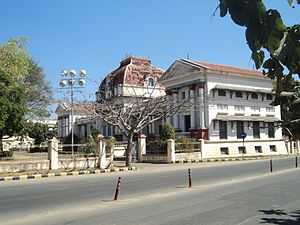Oriental Research Institute Mysore
Coordinates: 12°18′23.07″N 76°38′24.5″E / 12.3064083°N 76.640139°E The Oriental Research Institute (ORI) at Mysore, India is a research institute which collects, exhibits, edits and publishes rare manuscripts in Sanskrit and Kannada, with a few works in English, Tamil, and Telugu. Formerly it was known as the Oriental Library.
The Oriental Library was started in 1891 on the orders of His Highness Chamarajendra Wadiyar X, the then Maharaja of Mysore Kingdom. It is located at the northern end of the Krishnaraja Boulevard Road (adjacently opposite to the Crawford Hall wherein the University of Mysore is located), in the architecturally attractive Jubilee Hall built in 1887 to commemorate the golden jubilee of Queen Victoria`s accession to the British throne. It was a part of the Department of Education until 1916, in which year it became part of the newly established University of Mysore. The Oriental Library was renamed as the Oriental Research Institute in 1943.

Work
From the year 1893 to date the ORI has published nearly two hundred titles. The library features rare collections such as the Encyclopaedia of Religion and Ethics by James Hastings, A Vedic Concordance by Maurice Bloomfield, and critical editions of the Ramayana and Mahabharata. It was the first public library in Mysore city for research and editing of manuscripts. The prime focus was on Indology. The institute publishes an annual journal called Mysore Orientalist. Its most famous publications include Kautilya's Arthashastra, written in the 4th century B.C, edited by Dr. R. Shamashastri, which brought international fame to the institute when published in 1909. Sritattvanidhi, is a compilation of slokas by Krishnaraja Wodeyar III. Three edited manuscripts Navaratnamani-mahatmyam (a work on gemology), Tantrasara-sangraha (a work on sculptures and architecture), and Vaidashastra-dipika (an ayurvedic text), all of them with English and Kannada translation, are already in advanced stages of printing. Two more works, Rasa-kaumudi (on mercurial medicine) and Paryayapadamanjari (ayurvedic materia medica) have been edited and are awaiting publication.
The ORI houses over 33,000 Palm leaf manuscripts. The manuscripts are palm leaves cut to a standard size of 15 cm by 3.5 cm. Brittle palm leaves are sometimes softened by scrubbing a paste made of ragi and then used by the ancients for writing, similar to the use of papyrus in ancient Egypt. Manuscripts are organic materials that run the risk of decay and are prone to be destroyed by silverfish. To preserve them the ORI applies lemon grass oil on the manuscripts which acts like a pesticide. The lemon grass oil also injects natural fluidity into the brittle palm leaves and the hydrophobic nature of the oil keeps the manuscripts dry so that the text is not lost to decay due to humidity.
The conventional method followed at the ORI was to preserve manuscripts by capturing them in microfilm, which then necessitated the use of a microfilm reader for viewing or studying. Once the ORI has digitized the manuscripts, the text can be viewed and manipulated by a computer. Software is then used to put together disjointed pieces of manuscripts and to correct or fill in any missing text. In this manner, the manuscripts are restored and enhanced. The original palm leaf manuscripts are also on reference at the ORI for those interested.
Notable researchers
- A.R. Krishnashastry
- Dr. R. Shamasastry
- T. T. Srinivasagopalachar
References
- An article in The Hindu - A monumental heritage
- An Article in Hindu - Mysore varsity renovating Oriental Research Institute
- An article in Jan Samachar
- An article in Star of Mysore about Arthashastra manuscript
- Of oriental history, Times of India
| ||||||||||||||||||||||||||||||||||